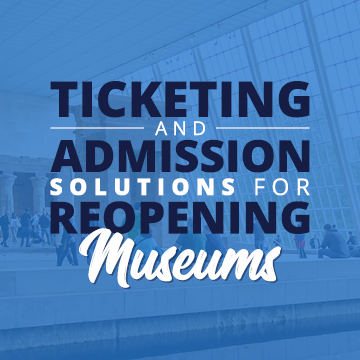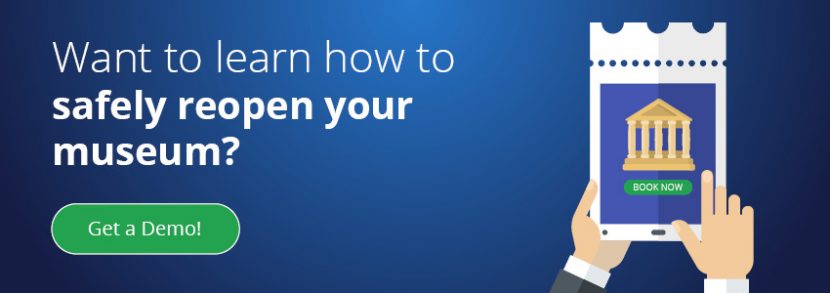Ticketing and Admission Solutions for Reopening Museums

Museums are eager to bring back staff, open their doors, serve their communities, and generate much-needed revenue as soon as shelter-in-place and other restrictions are lifted. To protect visitors and staff, the decision to reopen must be backed with procedures and policies that comply with social distancing and other health-related guidelines. This article discusses ticketing and admissions processes that support a safer reopening.

Timed Ticketing and Capacity Management
Most admission-based nonprofits including museums, zoos and aquariums, nature centers and public gardens are choosing to implement time-based ticketing. Organizations that serve high volumes of visitors may already have a timed-admission ticketing solution in place for special exhibits, IMAX shows, docent- and facilitator-led tours, and similar time-and-capacity-controlled experiences. In addition, some museums may already have a reservations system for booking group visits, field trips, and birthday parties that can be adapted to manage timed-entry admissions.
Timed ticketing empowers museums to tightly control the number of visitors, limit the amount of time that visitors may spend in the museum, and create entry and exit schedules that provide adequate time for full-scale cleaning and disinfecting before the next set of visitors arrive.
An ideal timed-ticketing solution will offer flexibility to accommodate sudden changes in operating conditions and health guidelines by increasing or decreasing capacity and hours of operation. In addition, the system should make it easy to issue refunds or transfer reservations to another date in case of unexpected closures.

Mandatory Agreements, Liability Forms and Waivers
Concerns about coronavirus transmission are especially significant for hands-on interactive museums that must reduce the chances of admitting an ill visitor as well as reduce the risk that healthy visitors and staff will contract coronavirus from asymptomatic carriers.
To ensure that visitors understand the possible health risks as well as your new attendance policies and behavior guidelines, you can require that purchasers read and accept your agreements, liability forms, and waivers before they can complete their online ticket purchase. Items that they must agree to may include (but are certainly not limited to) the following:
- Visitors will not knowingly enter the museum if a member of their party is exhibiting symptoms or has been exposed to a person with coronavirus within 14 days of the visit.
- Visitors will not hold the museum responsible if a member of their party is diagnosed with coronavirus within 14 days after their visit.
- If your visitors typically include children (such as a children's museum or hands-on science center), visitors will closely monitor the children under their care to enforce social distancing as much as possible; to make best efforts to prevent children from exploring exhibits and manipulatives by mouth; and to refrain from touching their nose and face as much as possible. It’s unlikely that any parent would have a 100-percent success rate, but it’s certainly important to try. (Depending on your site and exhibits, you might also ask adults to agree that if children place something in their mouths, their adult will place it in a “slobber box” and apply hand sanitizer to the child’s and their own hands.)
NOTE: As always, consult your legal advisors about the content and language of your forms.

Contact-Free Admissions and Check-in
In a more perfect world, all visitors would buy their tickets online in advance and there would be no need for on-site POS transactions during the coronavirus pandemic. But, converting to a mandatory online-only sales format can present access issues for communities on the wrong side of the digital divide. And, if visitors need to cancel their tickets, you may find yourself with unused capacity that could be translated to additional revenue.
If your museum chooses to support walk-up ticket sales, safer practices may include:
- Equipping admissions staff with masks and gloves
- Providing hand sanitizer at every register and asking visitors to use it before beginning any kind of transaction, especially cash
- Supporting NFC (near-field communications) payment methods like Apple Pay and Google Pay so visitors only need to touch their own smartphones
- Asking visitors to dip, tap or swipe their own credit cards
- Issuing tickets and receipts by text and email instead of printing
Ways to help ticketed guests enter the museum quickly and safely include the following:
- To speed entry, issue a single group ticket instead of individual tickets so families and groups can be checked in at once.
- For contact-free entry, staff can stand back and validate visitors by ticket number, purchaser name or other identifying information.
- If your ticketing solution offers a mobile app, you can eliminate lines during busy arrival periods by quickly deploying staff with iPads or smartphones.
If you have admissions turnstiles, consider asking visitors to walk through them backwards so they don’t use their hands. (It’s possible to walk forward through a turnstile hands-free, but it may be difficult to break the habit of manually pushing the turnstile.)

Easy Day-of-Visit Rescheduling and Refunds
If a visitor arrives with a fever, cough, runny nose, or other symptoms of illness, you’ll want to quickly issue refunds on the spot, reissue tickets for a later date, or convert the purchase amount to an electric gift card that can be used to buy tickets in the future. Gift cards may be more appealing than immediately rescheduling because they allow visitors to choose a return date at their leisure.

Group Visits and Birthday Parties
Reducing overall capacity will also impact your ability to support group visits, field trips, and birthday parties. If you plan to allow group visits and parties during general admission periods, you may need to scale back the number of groups and tightly control headcount so you don’t exceed a safe capacity.
Some of the same timed-ticketing systems that you use for reserving admissions will also support self-scheduling of birthday parties and field trips. This allows parents and group leaders to know immediately which time slots are available, eliminating the need for “phone tag” and multiple email exchanges to find suitable dates and times to accommodate different groups.

Membership Still Matters
If you’re evaluating a new reservations timed-entry ticketing system for the near-term goal of reopening, you might not be looking past your immediate needs for the next several months. However, integrating membership management with your reserved-ticketing system makes it easier to reward and retain current members and recruit new ones.
At a minimum, members should be able to reserve admission tickets at no cost. You can encourage new memberships and renewals with benefits like members-only hours, or by setting aside a daily block of members-only tickets that show real-time availability with a prominent link to purchase a membership; being able to book tickets for their first choice of date and time can be an effective incentive.
After weeks or months of staying at home, families and children will be more eager than ever to be engaged and inspired. Both your visitors and your staff will appreciate your efforts to make returning to your museum safer.


